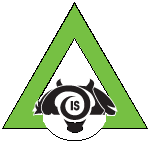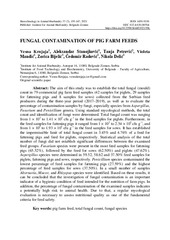Prikaz osnovnih podataka o dokumentu
Fungal contamination of pig farm feeds
| dc.creator | Krnjaja, Vesna | |
| dc.creator | Stanojković, Aleksandar | |
| dc.creator | Petrović, Tanja | |
| dc.creator | Mandić, Violeta | |
| dc.creator | Bijelić, Zorica | |
| dc.creator | Radović, Čedomir | |
| dc.creator | Delić, Nikola | |
| dc.date.accessioned | 2021-07-22T10:27:07Z | |
| dc.date.available | 2021-07-22T10:27:07Z | |
| dc.date.issued | 2021 | |
| dc.identifier.issn | 1450-9156 | |
| dc.identifier.uri | http://r.istocar.bg.ac.rs/handle/123456789/732 | |
| dc.description.abstract | The aim of this study was to establish the total fungal (mould) count in 79 commercial pig farm feed samples (42 samples for piglets, 29 samples for fattening pigs and 8 samples for sows) collected from the Serbian feed producers during the three-year period (2017–2019), as well as to evaluate the percentage of contamination samples by fungi, especially species from Aspergillus, Fusarium and Penicillium genera. Using standard mycological methods, the total count and identification of fungi were determined. Total fungal count was ranging from 1 × 102 to 1.41 × 105 cfu g–1 in the feed samples for piglets. Furthermore, in the feed samplesfor fattening pigs it ranged from 1 × 102 to 2.54 × 105 cfu g–1 , and from 1 × 102 to 1.93 × 105 cfu g–1 in the feed samples for sows. It has established the impermissible limit of total fungal count in 3.45% and 4.76% of a feed for fattening pigs and feed for piglets, respectively. Statistical analysis of the total number of fungi did not establish significant differences between the examined feed groups. Fusarium species were present in the most feed samples for fattening pigs (65.52%), followed by the feed for sows (62.50%) and piglets (47.62%). Aspergillus species were determined in 59.52, 58.62 and 37.50% feed samples for piglets, fattening pigs and sows, respectively. Penicillium species contaminated the lowest percentage of feed samples for fattening pigs (27.59%) and the highest percentage of feed samples for sows (37.50%). In a small number of samples Alternaria, Mucor, and Rhizopus species were identified. Based on these results, it can be concluded that the investigation of fungal contamination is an important indicator of a hygienic condition of feed intended for the nutrition of farm pigs. In addition, the percentage of fungal contamination of the examined samples indicates a potentially high risk to animal health. Due to that, a regular mycological evaluation is necessary to assess nutritional quality as one of the fundamental criteria for feed safety. | sr |
| dc.language.iso | en | sr |
| dc.relation | info:eu-repo/grantAgreement/MESTD/inst-2020/200022/RS// | sr |
| dc.rights | openAccess | sr |
| dc.rights.uri | https://creativecommons.org/licenses/by/4.0/ | |
| dc.source | Biotechnology in Animal Husbandry | sr |
| dc.subject | pig farm feed | sr |
| dc.subject | total fungal count | sr |
| dc.subject | fungal species | sr |
| dc.title | Fungal contamination of pig farm feeds | sr |
| dc.type | article | sr |
| dc.rights.license | BY | sr |
| dcterms.abstract | Крњаја, Весна; Делић, Никола; Радовић, Чедомир; Бијелић, Зорица; Мандић, Виолета; Петровић, Тања; Станојковић, Aлександар; Фунгал цонтаминатион оф пиг фарм феедс; Фунгал цонтаминатион оф пиг фарм феедс; | |
| dc.citation.volume | 37 | |
| dc.citation.issue | 2 | |
| dc.citation.spage | 139 | |
| dc.citation.epage | 147 | |
| dc.identifier.doi | 10.2298/BAH2102139K | |
| dc.identifier.fulltext | http://r.istocar.bg.ac.rs/bitstream/id/3889/bitstream_3889.pdf | |
| dc.type.version | publishedVersion | sr |


